|
A Look Inside a Victorian
Home
by Bob
Brooke
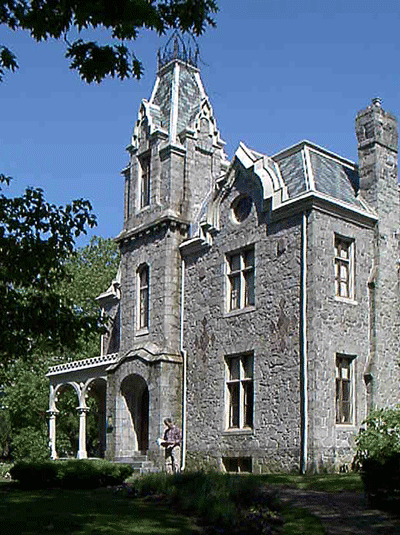 There
are lots of Victorian houses still in existence across the country.
People live in most of them. Some of them have grand restored
interiors and exteriors while others have fallen on hard times. A
very few have been turned into museums, compared to houses dating
from the late 18th and early 19th centuries. One such house, the
Ebenezer Maxwell Mansion, in the Germantown section of Philadelphia,
has been lovingly preserved as an example of Victorian living from
the 1860s to the 1880s. There
are lots of Victorian houses still in existence across the country.
People live in most of them. Some of them have grand restored
interiors and exteriors while others have fallen on hard times. A
very few have been turned into museums, compared to houses dating
from the late 18th and early 19th centuries. One such house, the
Ebenezer Maxwell Mansion, in the Germantown section of Philadelphia,
has been lovingly preserved as an example of Victorian living from
the 1860s to the 1880s.
Although it’s called a mansion, this house isn’t any larger than
others in the neighborhood off Germantown Avenue. In fact, some of
them are grander but are private homes. Many have been modernized
and converted to today’s lifestyle. But the authentically restored
Maxwell Mansion retains its Victorian integrity, down to every
detail.
The Ebenezer Maxwell mansion, built by Ebenezer Maxwell, a cloth
merchant, and his wife, Anna Smith Maxwell in 1859, is an
authentically restored house of wood and local schist stone
surrounded by an extensive garden.
This Victorian Gothic extravaganza of elongated windows, arches and
a three-story tower rising behind a cluster of trees was the result
of Maxwell’s business success.
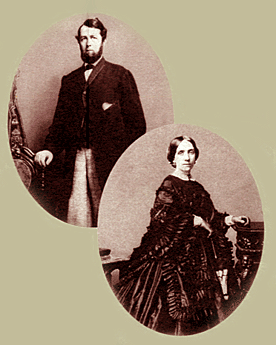 Born
on a farm in upstate New York in 1827, Ebenezer Maxwell came to
Philadelphia in his early twenty’s to take a job as a salesman for a
wholesale drug importer. Two years later, he went into the dry goods
business with William Bangs, whom he had met in their downtown
rooming house. They began by purchasing fabric from textile
manufacturers, then selling that material to jobbers, who, in turn,
sold the finished clothing to retail stores. In 1859 Maxwell married
his second cousin, Anna Smith, daughter in a well-to-do Quaker
family. That same year Anna’s father died and her inheritance
contributed to the expansion of the Maxwell and Bangs textile trade.
With their children, the Maxwells moved to the tranquility of the
new suburbs where the Maxwells built their new home. Born
on a farm in upstate New York in 1827, Ebenezer Maxwell came to
Philadelphia in his early twenty’s to take a job as a salesman for a
wholesale drug importer. Two years later, he went into the dry goods
business with William Bangs, whom he had met in their downtown
rooming house. They began by purchasing fabric from textile
manufacturers, then selling that material to jobbers, who, in turn,
sold the finished clothing to retail stores. In 1859 Maxwell married
his second cousin, Anna Smith, daughter in a well-to-do Quaker
family. That same year Anna’s father died and her inheritance
contributed to the expansion of the Maxwell and Bangs textile trade.
With their children, the Maxwells moved to the tranquility of the
new suburbs where the Maxwells built their new home.
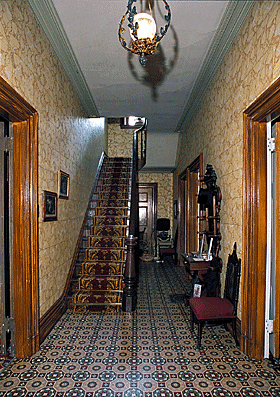 As
you enter the center hall of the house today, you’ll feel as if the
Maxwells have just stepped out for a moment. Gazing around, you’ll
discover the comforts and taste of the rising middle class during
the Victorian Era when central heat, indoor plumbing, and running
water were luxuries and when gas lighting, grained woodwork and
stencil ceiling decorations were emblems of social standing. As
you enter the center hall of the house today, you’ll feel as if the
Maxwells have just stepped out for a moment. Gazing around, you’ll
discover the comforts and taste of the rising middle class during
the Victorian Era when central heat, indoor plumbing, and running
water were luxuries and when gas lighting, grained woodwork and
stencil ceiling decorations were emblems of social standing.
Nothing was too good for Maxwell, and he made sure that his family
enjoyed all the luxuries and other modern conveniences of the time,
although he wasn’t against saving money where he could during
construction. He installed gas lights to light the rooms, gas
hot-air central heating to warm them, and hot and cold running water
to make life easier for both the family and the servants. The indoor
plumbing initially installed still required some modifications,
though, and during the Maxwell's stay in the house, they resorted to
using indoor chamber pots and an outhouse close to the main
building.
The house’s first floor has been restored to depict Victorian life
in the 1860s. The parlor and dining room are resplendent with fine
manufactured Rococo Revival furniture of the period.
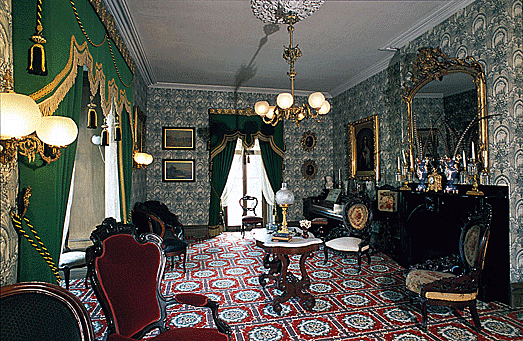
As you peer into the spacious parlor, you notice the solar lamp sitting
on the marbletop table in its center. Surrounding this parlor table with
its overhead gas chandelier, is an assortment of elegant Rococo Revival
sofas and chairs. Two of them have delicate needlepoint upholstered
backs. The room is large enough to entertain number of guests in small
sitting areas. A small table and chairs sits in a windowed alcove
overlooking the garden. A large black marble fireplace with large gilded
mirror above it, acts as the room’s focal point. The wallpapered walls
and carpeting are an explosion of pattern.
Anna Maxwell originally got the idea for her parlor window treatments
from Gleason’s Pictorial Drawing Room Companion of 1854. The lambrequin
at the top, full side drapes and ties and the lace or “glass” curtains
represent the style of 1860. The current parlor wallpaper, installed in
the French style—from floor to ceiling—is a Scalamandre Rococo Revival
reproduction from the time period. She had gilded mirrors installed to
reflect the dim light from the gasoliers.
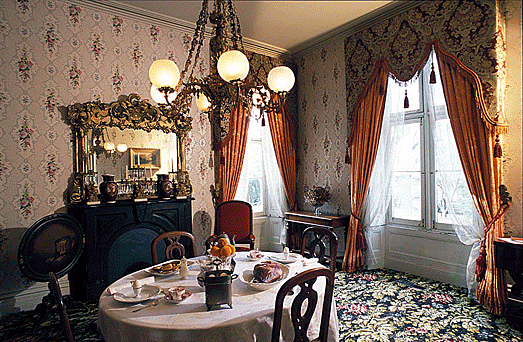
Large windows enable sunlight to stream into the dining room. A small
oval table is set for breakfast. A floral pattern carpet lays out a
bouquet to catch the sun.
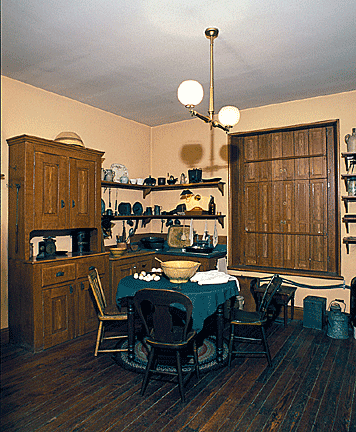 Compared
to the elegance of the parlor and dining room, the Maxwell’s kitchen was
utilitarian. Used mostly by the servants and the Maxwell children, it
features all sorts of modern appliances, such as an apple corer, hand
mixer, and bean slicer, to name a few. Other features include bin for
flour canisters and open shelves for ready access to kitchen utensils.
Built in wood-grained cabinets and sink gives it an early modern look. A
large, two-burner coal stove, used to cook food, stands in the corner. Compared
to the elegance of the parlor and dining room, the Maxwell’s kitchen was
utilitarian. Used mostly by the servants and the Maxwell children, it
features all sorts of modern appliances, such as an apple corer, hand
mixer, and bean slicer, to name a few. Other features include bin for
flour canisters and open shelves for ready access to kitchen utensils.
Built in wood-grained cabinets and sink gives it an early modern look. A
large, two-burner coal stove, used to cook food, stands in the corner.
Since gas was more expensive to use than wood or coal, Maxwell decided
to install a coal stove in the kitchen. At the time, people feared gas
explosions, so they were reluctant to use gas stoves in their kitchens.
Servants used the stove not only for cooking but also for heating water
in the copper hot water boiler.
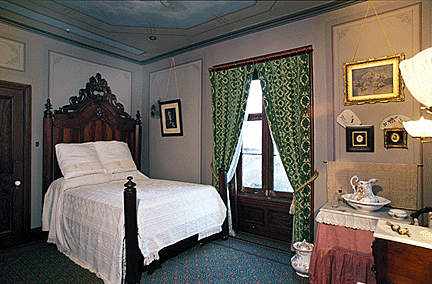 The
upstairs bedrooms will give you a glimpse of what life in the 1860s was
like. The stenciled wooden doors, painted ceilings, and ornate plaster
work attested to the detail which the Maxwells paid to decoration. The
upstairs bedrooms will give you a glimpse of what life in the 1860s was
like. The stenciled wooden doors, painted ceilings, and ornate plaster
work attested to the detail which the Maxwells paid to decoration.
Victorian bedrooms themselves may have been single rooms or suites and
used for not only sleeping but entertaining as well. The master bedroom
features an elegant Renaissance Revival bed and matching marble-top
dresser with a large mirror. A small draped marble-top washstand stands
off to the side. Above all is a beautifully painted ceiling highlighted
by an insert of billowy clouds as if looking up at the sky.
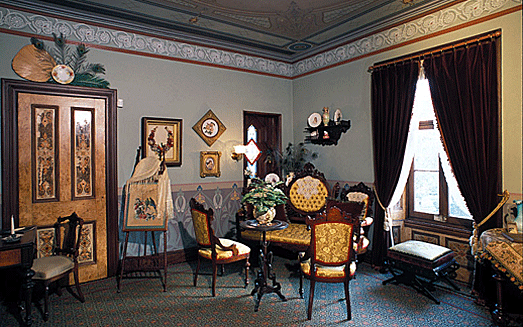
Another bedroom served as a ladie’s drawing room where Anna Maxwell may
have served tea to her lady friends who may have come over to gossip and
do embroidery. Other items in the room include a writing desk and day
bed. Again, the ceiling is beautifully decorated to complement the
elegant furnishings. The panels on the door to the hall contain
stenciled designs.
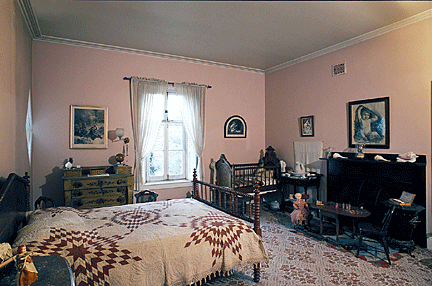 There’s
a large display of children's toys including doll houses, a small
theater stage, and an original Milton Bradley game of checkers in the
children’s bedroom. Painted cottage furniture, a spool bed, and a
Renaissance Revival crib complete the furnishings. There’s
a large display of children's toys including doll houses, a small
theater stage, and an original Milton Bradley game of checkers in the
children’s bedroom. Painted cottage furniture, a spool bed, and a
Renaissance Revival crib complete the furnishings.
Outside, gardens, enclosed by the mansion's original iron fence, a folk
landscape design of the mid- and late 19th-century. The cast iron deer
by the rock work, mounded berm, and irregular clusters of evergreens in
front of the house reflect the ideas of Andrew Jackson Downing, noted
early Victorian garden theorist. A ribbon garden surrounds fruit trees
on the side of the house, and roses climb the porch columns, recreating
the 1870s suburban landscape plantings of Frank J. Scott.
In the 1950s in early 1960s, neighbors and friends worked tirelessly to
prevent the mansion's destruction and promote its restoration. Today the
Maxwell mansion serves as a reminder of an important time in our
cultural heritage. It allows us a small window in which to view the life
of an upper middle class family during the Victorian Era.
<
Back to More Antiques to View
Next Article > |
